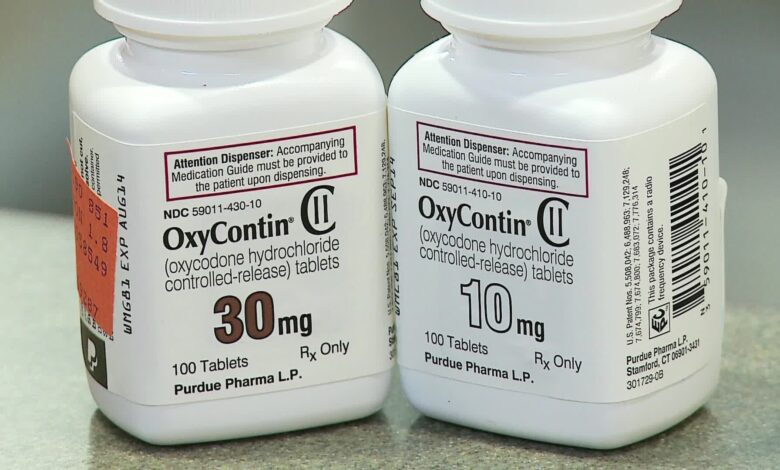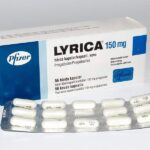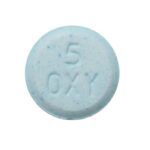Oxycodone: Uses, Side Effects, Abuse, Addiction

Oxycodone, sold under the brand names Roxicodone and OxyContin among others, belongs to a class of medications called opiate (narcotic) analgesics. It works by changing the way the brain and nervous system respond to pain. Oxycodone is used to relieve moderate to severe pain. Oxycodone extended-release tablets and extended-release capsules are used to relieve severe pain in people who are expected to need pain medication around the clock for a long time and who cannot be treated with other medications.
Oxycodone extended-release tablets and extended-release capsules should not be used to treat pain that can be controlled by medication that is taken as needed. Oxycodone extended-release tablets, extended-release capsules, and concentrated solution should only be used to treat people who are tolerant (used to the effects of the medication) to opioid medications because they have taken this type of medication for at least one week. It is highly addictive and is commonly used recreationally by people who have opioid use disorder. Oxycodone products are in Schedule II of the Controlled Substances Act.
How quickly does oxycodone work?
Oxycodone is a potent opioid, when taken orally in immediate-release form, it typically starts working within 15 to 30 minutes. However, the time it takes for oxycodone to take effect can vary from person to person.
Once oxycodone enters the bloodstream, it binds to opioid receptors in the brain and spinal cord, reducing the perception of pain. The onset of its analgesic effects can depend on several factors, including the individual’s metabolism, overall health, and whether the medication is taken on an empty or full stomach.
It’s important to note that while oxycodone can provide effective pain relief, it is a powerful opioid medication that carries a risk of side effects and potential addiction. It should only be used as directed by a healthcare professional and in the prescribed dosage. If you have any concerns or questions about oxycodone or its effects, it’s best to consult with a healthcare provider.
How should oxycodone be used?
Oxycodone comes as a solution (liquid), a concentrated solution, a tablet, a capsule, an extended-release (long-acting) tablet (Oxycontin), and an extended-release capsule (Xtampza ER) to take by mouth. The solution, concentrated solution, tablet, and capsule are taken usually with or without food every 4 to 6 hours, either as needed for pain or as regularly scheduled medications. The extended-release tablets (Oxycontin) are taken every 12 hours with or without food. The extended-release capsules (Xtampza ER) are taken every 12 hours with food; eat the same amount of food with each dose. Follow the directions on your prescription label carefully, and ask your doctor or pharmacist to explain any part you do not understand. Take oxycodone exactly as directed.
If you are taking Oxaydo brand tablets, swallow the tablets one at a time with plenty of water. Swallow the tablet or right after putting it in your mouth. Do not presoak, wet, or lick the tablets before you put them in your mouth. Do not chew or crush Oxaydo brand tablets and do not give them through a nasogastric tube (NG tube; a tube threaded through the nose to deliver food and medication directly to the stomach).
If you have trouble swallowing extended-release capsules (Xtampza ER), you can carefully open the capsule and sprinkle the contents on soft foods such as applesauce, pudding, yogurt, ice cream, or jam, then consume the mixture immediately. Dispose of the empty capsule shells right away by flushing them down a toilet. Do not store the mixture for future use.
If you have a feeding tube, the extended-release capsule contents can be poured into the tube. Ask your doctor how you should take the medication and follow these directions carefully.
If you are taking the concentrated solution, your doctor may tell you to mix the medication in a small amount of juice or semisolid food such as pudding or applesauce. Follow these directions carefully. Swallow the mixture right away; do not store it for later use.
Your doctor will likely start you on a low dose of oxycodone and may increase this dose over time if your pain is not controlled. After you take oxycodone for a period of time, your body may become used to the medication. If this happens, your doctor may need to increase your dose to control your pain. Your doctor may decrease your dose if you experience side effects. Talk to your doctor about how you are feeling during your treatment with oxycodone.
Do not stop taking oxycodone without talking to your doctor. If you stop taking this medication suddenly, you may experience withdrawal symptoms such as restlessness, watery eyes, runny nose, sneezing, yawning, sweating, chills, muscle or joint aches or pains, weakness, irritability, anxiety, depression, difficulty falling asleep or staying asleep, cramps, nausea, vomiting, diarrhea, loss of appetite, fast heartbeat, and fast breathing. Your doctor will probably decrease your dose gradually.
What side effects can this medication cause?
Oxycodone may cause side effects. Tell your doctor if any of these symptoms, are severe or do not go away:
- dry mouth
- stomach pain
- drowsiness
- flushing
- headache
- mood changes
Some side effects can be serious. If you experience any of these symptoms call your doctor immediately or get emergency medical help:
- changes in heartbeat
- agitation, hallucinations (seeing things or hearing voices that do not exist), fever, sweating, confusion, fast heartbeat, shivering, severe muscle stiffness or twitching, loss of coordination, nausea, vomiting, or diarrhea
- nausea, vomiting, loss of appetite, weakness, or dizziness
- inability to get or keep an erection
- irregular menstruation
- decreased sexual desire
- chest pain
- hives
- itching
- rash
- swelling of the face, throat, tongue, lips, eyes, hands, feet, ankles, or lower legs
- hoarseness
- difficulty breathing or swallowing
- seizures
- extreme drowsiness
- lightheadedness when changing positions
Oxycodone Safety Information
Oxycodone may be habit-forming. Take oxycodone exactly as directed. Do not take more of it, take it more often, or take it in a different way than directed by your doctor. While taking oxycodone, discuss with your healthcare provider your pain treatment goals, length of treatment, and other ways to manage your pain. Tell your doctor if you or anyone in your family drinks or has ever drunk large amounts of alcohol, uses or has ever used street drugs, or has overused prescription medications, or has had an overdose, or if you have or have ever had depression or another mental illness. There is a greater risk that you will overuse oxycodone if you have or have ever had any of these conditions. Talk to your healthcare provider immediately and ask for guidance if you think that you have an opioid addiction or call the U.S. Substance Abuse and Mental Health Services Administration (SAMHSA) National Helpline at 1-800-662-HELP.
Oxycodone may cause serious or life-threatening breathing problems, especially during the first 24 to 72 hours of your treatment and any time your dose is increased. Your doctor will monitor you carefully during your treatment. Tell your doctor if you have or have ever had slowed breathing or asthma. Your doctor will probably tell you not to take oxycodone. Also tell your doctor if you have or have ever had lung disease such as chronic obstructive pulmonary disease (COPD; a group of diseases that affect the lungs and airways), a head injury a brain tumor, or any condition that increases the amount of pressure in your brain. The risk that you will develop breathing problems may be higher if you are an older adult or are weak or malnourished due to disease. If you experience any of the following symptoms, call your doctor immediately or get emergency medical treatment: slowed breathing, long pauses between breaths, or shortness of breath.
Taking certain other medications with oxycodone may increase the risk of serious or life-threatening breathing problems, sedation, or coma. Tell your doctor and pharmacist if you are taking or plan to take any of the following medications: certain antibiotics such as clarithromycin (Biaxin, in PrevPac) and erythromycin (Erytab, Erythrocin); certain antifungal medications including itraconazole (Onmel, Sporanox), ketoconazole (Nizoral), and voriconazole (Vfend); benzodiazepines such as alprazolam (Xanax), chlordiazepoxide (Librium), clonazepam (Klonopin), diazepam (Diastat, Valium), estazolam, flurazepam, lorazepam (Ativan), oxazepam, temazepam (Restoril), and triazolam (Halcion); carbamazepine (Carbatrol, Epitol, Equetro, Tegretol, Teril); medications for mental illness, nausea or pain; muscle relaxants; certain medications for human immunodeficiency virus (HIV) including indinavir (Crixivan), nelfinavir (Viracept), and ritonavir (Norvir, in Kaletra); phenytoin (Dilantin, Phenytek); rifabutin (Mycobutin), rifampin (Rifadin, Rimactane, in Rifamate); sedatives; sleeping pills; or tranquilizers. Your doctor may need to change the doses of your medication and will monitor you carefully. If you take oxycodone with any of these medications and you develop any of the following symptoms, call your doctor immediately or seek emergency medical care: unusual dizziness, lightheadedness, extreme sleepiness, slowed or difficult breathing, or unresponsiveness. Be sure that your caregiver or family members know which symptoms may be serious so they can call the doctor or emergency medical care if you are unable to seek treatment on your own.
Drinking alcohol, taking prescription or nonprescription medications that contain alcohol, or using street drugs during your treatment with oxycodone increases the risk that you will experience serious, life-threatening side effects. Do not drink alcohol, take prescription or nonprescription medications that contain alcohol, or use street drugs during your treatment.
If you are taking the oxycodone extended-release tablets, swallow them whole; do not chew, break, divide, crush, or dissolve them. Do not presoak, lick or otherwise wet the tablet prior to placing in the mouth. Swallow each tablet right after you put it in your mouth. If you swallow broken, chewed, crushed, or dissolved extended-release tablets, you may receive too much oxycodone at once instead of slowly over 12 hours. This may cause serious problems, including overdose and death.
Oxycodone comes as a regular solution (liquid) and as a concentrated solution that contains more oxycodone in each milliliter of solution. Be sure that you know whether your doctor has prescribed the regular or concentrated solution and the dose in milliliters that your doctor has prescribed. Use the dosing cup, oral syringe, or dropper provided with your medication to carefully measure the number of milliliters of solution that your doctor prescribed. Read the directions that come with your medication carefully and ask your doctor or pharmacist if you have any questions about how to measure your dose or how much medication you should take. You may experience serious or life threatening side effects if you take an oxycodone solution with a different concentration or if you take a different amount of medication than prescribed by your doctor.
Tell your doctor if you are pregnant or plan to become pregnant. If you take oxycodone regularly during your pregnancy, your baby may experience life-threatening withdrawal symptoms after birth. Tell your baby’s doctor right away if your baby experiences any of the following symptoms: irritability, hyperactivity, abnormal sleep, high-pitched cry, uncontrollable shaking of a part of the body, vomiting, diarrhea, or failure to gain weight.
Talk to your doctor about the risks of taking oxycodone. Your doctor or pharmacist will give you the manufacturer’s patient information sheet (Medication Guide) when you begin your treatment with oxycodone and each time you fill your prescription. Read the information carefully and ask your doctor or pharmacist if you have any questions. You can also visit the Food and Drug Administration (FDA) website.
How to overcome oxycodone abuse
Overcoming oxycodone abuse can be challenging, but with the right approach and support, it is possible to regain control of your life. Here are some steps you can take to address oxycodone abuse:
1. Acknowledge the problem: Recognize and accept that you have a problem with oxycodone abuse. Admitting the issue is the first step towards recovery.
2. Seek professional help: Consult a healthcare professional who specializes in addiction medicine. They can provide guidance, assess your situation, and develop a tailored treatment plan.
3. Detoxification: If you have developed physical dependence on oxycodone, a medically supervised detoxification may be necessary. This process helps your body rid itself of the drug while managing withdrawal symptoms.
4. Consider medication-assisted treatment: In some cases, medications such as buprenorphine or methadone may be used to help manage withdrawal symptoms and cravings during the recovery process. These medications are typically prescribed under close medical supervision.
5. Therapy and counseling: Engage in individual therapy or counseling to address the underlying causes and triggers of your oxycodone abuse. Cognitive-behavioral therapy (CBT) and other evidence-based approaches can help you develop healthier coping mechanisms and prevent relapse.
6. Support groups: Joining support groups, such as Narcotics Anonymous (NA) or other addiction support groups, can provide a sense of community and understanding. Sharing experiences and learning from others who have faced similar challenges can be empowering.
7. Create a support network: Surround yourself with supportive and understanding individuals who can encourage your recovery journey. Inform your friends and family about your struggles so that they can offer assistance and encouragement.
8. Develop healthy coping strategies: Find alternative ways to manage stress and pain without relying on oxycodone. Explore activities like exercise, mindfulness, meditation, hobbies, or creative outlets to help distract from cravings and promote well-being.
9. Make lifestyle changes: Identify and address any environmental factors or triggers that contribute to your drug abuse. This may involve changing your social circle, avoiding situations associated with drug use, and adopting a healthy lifestyle.
10. Practice self-care: Focus on self-care and prioritize your physical and mental well-being. Get enough sleep, eat a nutritious diet, and engage in activities that bring you joy and relaxation.
Remember, overcoming oxycodone abuse is a journey that requires commitment, patience, and professional support. It’s crucial to seek help from healthcare professionals who can provide appropriate guidance and develop an individualized treatment plan based on your specific needs.




